Jiahui Chen
CroPS: Improving Dense Retrieval with Cross-Perspective Positive Samples in Short-Video Search
Nov 19, 2025Abstract:Dense retrieval has become a foundational paradigm in modern search systems, especially on short-video platforms. However, most industrial systems adopt a self-reinforcing training pipeline that relies on historically exposed user interactions for supervision. This paradigm inevitably leads to a filter bubble effect, where potentially relevant but previously unseen content is excluded from the training signal, biasing the model toward narrow and conservative retrieval. In this paper, we present CroPS (Cross-Perspective Positive Samples), a novel retrieval data engine designed to alleviate this problem by introducing diverse and semantically meaningful positive examples from multiple perspectives. CroPS enhances training with positive signals derived from user query reformulation behavior (query-level), engagement data in recommendation streams (system-level), and world knowledge synthesized by large language models (knowledge-level). To effectively utilize these heterogeneous signals, we introduce a Hierarchical Label Assignment (HLA) strategy and a corresponding H-InfoNCE loss that together enable fine-grained, relevance-aware optimization. Extensive experiments conducted on Kuaishou Search, a large-scale commercial short-video search platform, demonstrate that CroPS significantly outperforms strong baselines both offline and in live A/B tests, achieving superior retrieval performance and reducing query reformulation rates. CroPS is now fully deployed in Kuaishou Search, serving hundreds of millions of users daily.
UniSearch: Rethinking Search System with a Unified Generative Architecture
Sep 10, 2025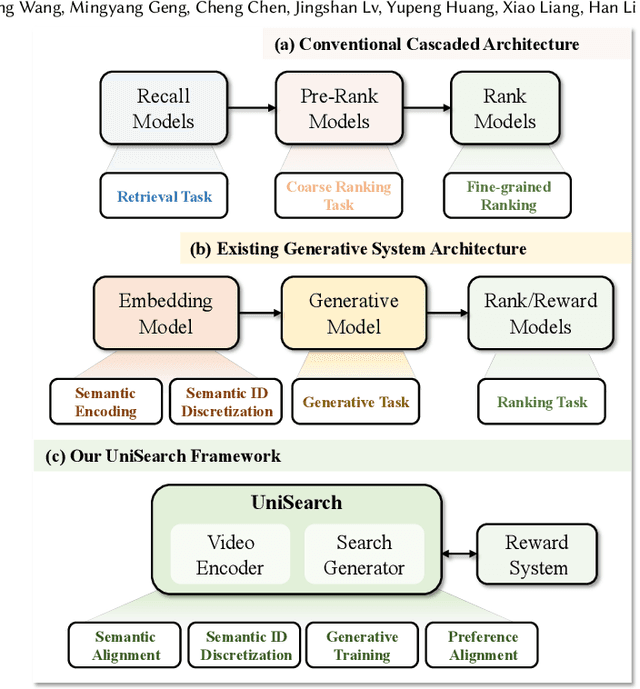
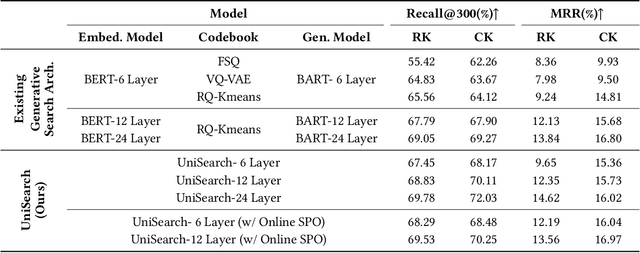
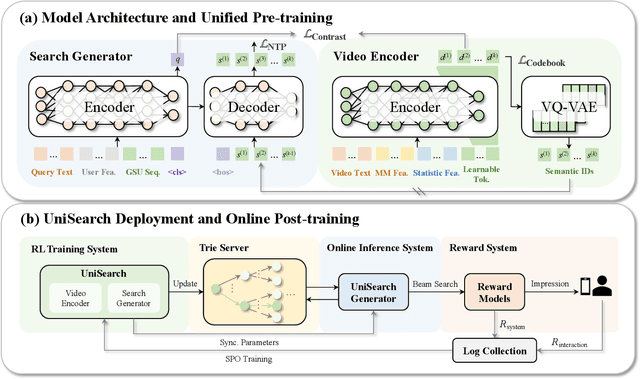
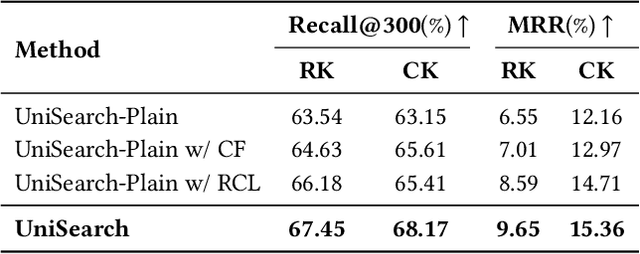
Abstract:Modern search systems play a crucial role in facilitating information acquisition. Traditional search engines typically rely on a cascaded architecture, where results are retrieved through recall, pre-ranking, and ranking stages. The complexity of designing and maintaining multiple modules makes it difficult to achieve holistic performance gains. Recent advances in generative recommendation have motivated the exploration of unified generative search as an alternative. However, existing approaches are not genuinely end-to-end: they typically train an item encoder to tokenize candidates first and then optimize a generator separately, leading to objective inconsistency and limited generalization. To address these limitations, we propose UniSearch, a unified generative search framework for Kuaishou Search. UniSearch replaces the cascaded pipeline with an end-to-end architecture that integrates a Search Generator and a Video Encoder. The Generator produces semantic identifiers of relevant items given a user query, while the Video Encoder learns latent item embeddings and provides their tokenized representations. A unified training framework jointly optimizes both components, enabling mutual enhancement and improving representation quality and generation accuracy. Furthermore, we introduce Search Preference Optimization (SPO), which leverages a reward model and real user feedback to better align generation with user preferences. Extensive experiments on industrial-scale datasets, together with online A/B testing in both short-video and live search scenarios, demonstrate the strong effectiveness and deployment potential of UniSearch. Notably, its deployment in live search yields the largest single-experiment improvement in recent years of our product's history, highlighting its practical value for real-world applications.
3D Vision-tactile Reconstruction from Infrared and Visible Images for Robotic Fine-grained Tactile Perception
Jun 18, 2025Abstract:To achieve human-like haptic perception in anthropomorphic grippers, the compliant sensing surfaces of vision tactile sensor (VTS) must evolve from conventional planar configurations to biomimetically curved topographies with continuous surface gradients. However, planar VTSs have challenges when extended to curved surfaces, including insufficient lighting of surfaces, blurring in reconstruction, and complex spatial boundary conditions for surface structures. With an end goal of constructing a human-like fingertip, our research (i) develops GelSplitter3D by expanding imaging channels with a prism and a near-infrared (NIR) camera, (ii) proposes a photometric stereo neural network with a CAD-based normal ground truth generation method to calibrate tactile geometry, and (iii) devises a normal integration method with boundary constraints of depth prior information to correcting the cumulative error of surface integrals. We demonstrate better tactile sensing performance, a 40$\%$ improvement in normal estimation accuracy, and the benefits of sensor shapes in grasping and manipulation tasks.
MTIL: Encoding Full History with Mamba for Temporal Imitation Learning
May 18, 2025Abstract:Standard imitation learning (IL) methods have achieved considerable success in robotics, yet often rely on the Markov assumption, limiting their applicability to tasks where historical context is crucial for disambiguating current observations. This limitation hinders performance in long-horizon sequential manipulation tasks where the correct action depends on past events not fully captured by the current state. To address this fundamental challenge, we introduce Mamba Temporal Imitation Learning (MTIL), a novel approach that leverages the recurrent state dynamics inherent in State Space Models (SSMs), specifically the Mamba architecture. MTIL encodes the entire trajectory history into a compressed hidden state, conditioning action predictions on this comprehensive temporal context alongside current multi-modal observations. Through extensive experiments on simulated benchmarks (ACT dataset tasks, Robomimic, LIBERO) and real-world sequential manipulation tasks specifically designed to probe temporal dependencies, MTIL significantly outperforms state-of-the-art methods like ACT and Diffusion Policy. Our findings affirm the necessity of full temporal context for robust sequential decision-making and validate MTIL as a powerful approach that transcends the inherent limitations of Markovian imitation learning
Multi-Modal Language Models as Text-to-Image Model Evaluators
May 01, 2025Abstract:The steady improvements of text-to-image (T2I) generative models lead to slow deprecation of automatic evaluation benchmarks that rely on static datasets, motivating researchers to seek alternative ways to evaluate the T2I progress. In this paper, we explore the potential of multi-modal large language models (MLLMs) as evaluator agents that interact with a T2I model, with the objective of assessing prompt-generation consistency and image aesthetics. We present Multimodal Text-to-Image Eval (MT2IE), an evaluation framework that iteratively generates prompts for evaluation, scores generated images and matches T2I evaluation of existing benchmarks with a fraction of the prompts used in existing static benchmarks. Moreover, we show that MT2IE's prompt-generation consistency scores have higher correlation with human judgment than scores previously introduced in the literature. MT2IE generates prompts that are efficient at probing T2I model performance, producing the same relative T2I model rankings as existing benchmarks while using only 1/80th the number of prompts for evaluation.
Audio-driven Gesture Generation via Deviation Feature in the Latent Space
Mar 27, 2025Abstract:Gestures are essential for enhancing co-speech communication, offering visual emphasis and complementing verbal interactions. While prior work has concentrated on point-level motion or fully supervised data-driven methods, we focus on co-speech gestures, advocating for weakly supervised learning and pixel-level motion deviations. We introduce a weakly supervised framework that learns latent representation deviations, tailored for co-speech gesture video generation. Our approach employs a diffusion model to integrate latent motion features, enabling more precise and nuanced gesture representation. By leveraging weakly supervised deviations in latent space, we effectively generate hand gestures and mouth movements, crucial for realistic video production. Experiments show our method significantly improves video quality, surpassing current state-of-the-art techniques.
Augmented Conditioning Is Enough For Effective Training Image Generation
Feb 06, 2025



Abstract:Image generation abilities of text-to-image diffusion models have significantly advanced, yielding highly photo-realistic images from descriptive text and increasing the viability of leveraging synthetic images to train computer vision models. To serve as effective training data, generated images must be highly realistic while also sufficiently diverse within the support of the target data distribution. Yet, state-of-the-art conditional image generation models have been primarily optimized for creative applications, prioritizing image realism and prompt adherence over conditional diversity. In this paper, we investigate how to improve the diversity of generated images with the goal of increasing their effectiveness to train downstream image classification models, without fine-tuning the image generation model. We find that conditioning the generation process on an augmented real image and text prompt produces generations that serve as effective synthetic datasets for downstream training. Conditioning on real training images contextualizes the generation process to produce images that are in-domain with the real image distribution, while data augmentations introduce visual diversity that improves the performance of the downstream classifier. We validate augmentation-conditioning on a total of five established long-tail and few-shot image classification benchmarks and show that leveraging augmentations to condition the generation process results in consistent improvements over the state-of-the-art on the long-tailed benchmark and remarkable gains in extreme few-shot regimes of the remaining four benchmarks. These results constitute an important step towards effectively leveraging synthetic data for downstream training.
Self-Supervised Learning of Deviation in Latent Representation for Co-speech Gesture Video Generation
Sep 26, 2024



Abstract:Gestures are pivotal in enhancing co-speech communication. While recent works have mostly focused on point-level motion transformation or fully supervised motion representations through data-driven approaches, we explore the representation of gestures in co-speech, with a focus on self-supervised representation and pixel-level motion deviation, utilizing a diffusion model which incorporates latent motion features. Our approach leverages self-supervised deviation in latent representation to facilitate hand gestures generation, which are crucial for generating realistic gesture videos. Results of our first experiment demonstrate that our method enhances the quality of generated videos, with an improvement from 2.7 to 4.5% for FGD, DIV, and FVD, and 8.1% for PSNR, 2.5% for SSIM over the current state-of-the-art methods.
LW-DETR: A Transformer Replacement to YOLO for Real-Time Detection
Jun 05, 2024



Abstract:In this paper, we present a light-weight detection transformer, LW-DETR, which outperforms YOLOs for real-time object detection. The architecture is a simple stack of a ViT encoder, a projector, and a shallow DETR decoder. Our approach leverages recent advanced techniques, such as training-effective techniques, e.g., improved loss and pretraining, and interleaved window and global attentions for reducing the ViT encoder complexity. We improve the ViT encoder by aggregating multi-level feature maps, and the intermediate and final feature maps in the ViT encoder, forming richer feature maps, and introduce window-major feature map organization for improving the efficiency of interleaved attention computation. Experimental results demonstrate that the proposed approach is superior over existing real-time detectors, e.g., YOLO and its variants, on COCO and other benchmark datasets. Code and models are available at (https://github.com/Atten4Vis/LW-DETR).
SimAD: A Simple Dissimilarity-based Approach for Time Series Anomaly Detection
May 18, 2024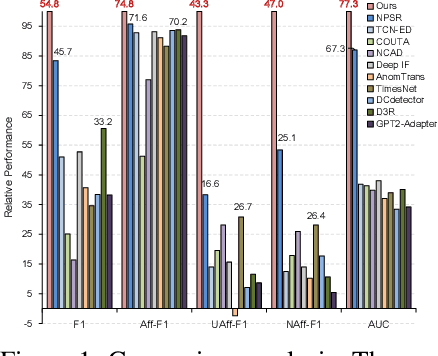

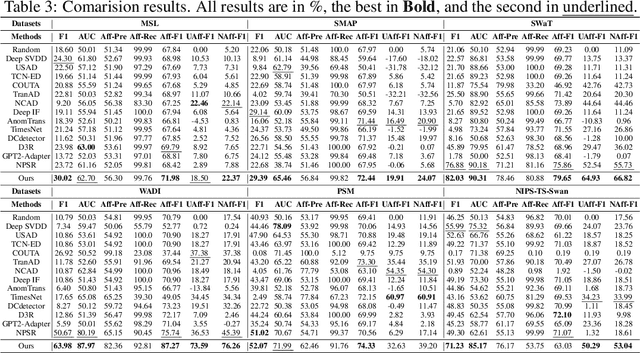

Abstract:Despite the prevalence of reconstruction-based deep learning methods, time series anomaly detection remains challenging. Existing approaches often struggle with limited temporal contexts, inadequate representation of normal patterns, and flawed evaluation metrics, hindering their effectiveness in identifying aberrant behavior. To address these issues, we introduce $\textbf{{SimAD}}$, a $\textbf{{Sim}}$ple dissimilarity-based approach for time series $\textbf{{A}}$nomaly $\textbf{{D}}$etection. SimAD incorporates an advanced feature extractor adept at processing extended temporal windows, utilizes the EmbedPatch encoder to integrate normal behavioral patterns comprehensively, and introduces an innovative ContrastFusion module designed to accentuate distributional divergences between normal and abnormal data, thereby enhancing the robustness of anomaly discrimination. Additionally, we propose two robust evaluation metrics, UAff and NAff, addressing the limitations of existing metrics and demonstrating their reliability through theoretical and experimental analyses. Experiments across $\textbf{seven}$ diverse time series datasets demonstrate SimAD's superior performance compared to state-of-the-art methods, achieving relative improvements of $\textbf{19.85%}$ on F1, $\textbf{4.44%}$ on Aff-F1, $\textbf{77.79%}$ on NAff-F1, and $\textbf{9.69%}$ on AUC on six multivariate datasets. Code and pre-trained models are available at https://github.com/EmorZz1G/SimAD.
 Add to Chrome
Add to Chrome Add to Firefox
Add to Firefox Add to Edge
Add to Edge